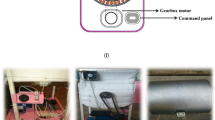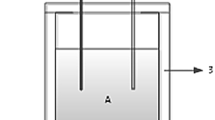Abstract
Purpose
Decentralised treatment of food waste (FW) by in-vessel composting by small-to-medium sized enterprises supports the proximity principle of waste management and recycling, but the process is susceptible to instability from acidogenic reactions and low process temperatures due to the high degradability and moisture content (MC) of the feedstock.
Methods
Physical and chemical parameters within an operational in-vessel FW composting reactor were monitored to determine the critical management factors controlling process acidification and activity. The process was monitored for 8 weeks during an initial period of sub-optimal operation due to severe acidogenesis, and after management interventions to re-establish normal composting activity.
Results
Interstitial gas analysis demonstrated that acidogenesis coincided with adequate O2 concentrations, therefore, the development of anaerobic conditions in the reactor, whilst a possible contributory mechanism, was not considered to be the main reason for process failure. The key factors influencing the pH value of the compost mixture and inhibiting the temperature rise to thermophilic conditions were identified as the FW MC and acidity. The influence of MC on composting temperature was probably initiated through its effect on the process thermodynamics by increasing thermal conductivity and losses and the specific heat of the composting mixture. This potentially restricted the temperature rise and the metabolism of organic acids reducing the pH value, which initiated a pH mediated feedback mechanism leading to further acidogenesis, aerobic microbial inhibition and temperature reduction.
Conclusions
The upper critical MC determined for in-vessel shredded FW composting was 40 %. Monitoring of CO2 evolution and O2 utilisation gave a good indication of the progress of the composting process.







Similar content being viewed by others

References
Waste and Resources Action Programme (WRAP): Love Food Hate Waste. http://england.lovefoodhatewaste.com/content/how-much-food-wasted-total-across-uk (2013). Accessed 18 July 2014
Lee, P., Willis, P.: Waste Arisings in the Supply of Food and Drink to Households in the UK. RSC002-005. WRAP, Banbury (2010)
Chapagain, A., James, K.: The Water and Carbon Footprint of Household Food and Drink Waste in the UK. Final Report. WRAP, Banbury. http://www.wrap.org.uk/content/water-and-carbon-footprint-household-food-and-drink-waste-uk-1 (2011). Accessed 18 July 2014
Environment Agency: Waste Fact Sheet. http://webarchive.nationalarchives.gov.uk/20140328084622/http://www.environment-agency.gov.uk/static/documents/Research/Waste_Fact_Sheet_for_SSD_Apr_10.pdf (2010). Accessed 18 July 2014
Council of the European Union (CEU): Council Directive of 26 April 1999 on the landfill of waste (99/31/EC). Official Journal of the European Communities No. L182/1-19, Brussels (1999)
European Parliament and the Council of the European Union (EPCEU): Regulation (EC) No 1069/2009 of the European Parliament and of the Council of 21 October 2009 laying down health rules as regards animal by-products and derived products not intended for human consumption and repealing Regulation (EC) No 1774/2002 (Animal by-products Regulation). Official Journal of the European Union No L300/1-33 (2009)
European Commission (EC): Commission Regulation (EU) No 142/2011 of 25 February 2011 implementing Regulation (EC) No 1069/2009 of the European Parliament and of the council laying down health rules as regards animal by-products and derived products not intended for human consumption and implementing council directive 97/78/EC as regards certain samples and items exempt from veterinary checks at the border under that Directive. Official Journal of the European Union No L54/1-254 (2011)
Haug, R.T.: The Practical Handbook of Compost Engineering. Lewis Publishers, Boca Raton (1993)
Gilbert, E.J., Riggle, D.S., Holland, F.D.: Large-Scale Composting a Practical Manual for the UK. The Composting Association, Northampton (2001)
Cebrian Gomez, M.G., Grimes, S.M., Moore, D.: In-vessel composting of food waste—a catering waste management solution. Commun. Waste Resour. Manag. 9, 19–23 (2008)
Sundberg, C., Jönsson, H.: Higher pH and faster decomposition in biowaste composting by increased aeration. Waste Manag. 28, 518–526 (2008)
Day, M., Krzymien, M., Shaw, K., Zaremba, L., Wilson, W.R., Botden, C., Thomas, B.: An investigation of the chemical and physical changes occurring during commercial composting. Compost Sci. Util. 6, 41–66 (1998)
Sundberg, C., Jönsson, H.: Process inhibition due to organic acids in fed-batch composting of food waste—influence of starting culture. Biodegradation 16, 205–213 (2005)
Chang, J.I., Hsu, T.-E.: Effects of compositions on food waste composting. Bioresour. Technol. 99, 8068–8074 (2008)
Beck-Friis, B., Smårs, S., Jönsson, H., Eklind, Y., Kirchmann, H.: Composting of source-separated household organics at different oxygen levels: gaining an understanding of the emission dynamics. Compost. Sci. Util. 11, 41–50 (2003)
Brinton, W.F.: Volatile organic acids in compost: production and odorant aspects. Compost. Sci. Util. 6, 75–82 (1998)
Nishino, T., Nakayama, T., Hemmi, H., Shimoyama, T., Yamashita, S., Akai, M., Kanagawa, T., Hoshi, K.: Acidulocomposting, an accelerated composting process of garbage under thermoacidophilic conditions for prolonged periods. J. Environ. Biotechnol. 3, 33–36 (2003)
Sundberg, C., Smårs, S., Jönsson, H.: Low pH as an inhibiting factor in the transition from mesophilic to thermophilic phase in composting. Bioresour. Technol. 95, 145–150 (2004)
Smårs, S., Gustafsson, L., Beck-Friis, B., Jönsson, H.: Improvement of the composting time for household waste during an initial low pH phase by mesophilic temperature control. Bioresour. Technol. 84, 237–241 (2002)
Susteco: Neter 30 Composter: Model 30.1 Operation and Maintenance. SustecoAB, Västra Frölunda, Sweden (2004)
British Standards Institution: BS EN 13040:2007 Soil Improvers and Growing Media—Sample Preparation for Chemical and Physical Tests, Determination of Dry Matter Content, Moisture Content and Laboratory Compacted Bulk Density. BSI, London (2008)
Niwagaba, C., Nalubega, M., Vinnerås, B., Sundberg, C., Jönsson, H.: Substrate composition and moisture in composting source-separated human faeces and food waste. Environ. Technol. 30, 487–497 (2009)
Skourides, I., Theophilou, C., Loizides, M., Hood, P., Smith, S.R.: Optimisation of an advanced biodrying technology for production of consistent auxiliary fuels from biodegradable municipal waste for industrial purposes. In: Waste 2006: Sustainable Waste and Resource Management, 19–21 September, Stratford-upon-Avon (2006)
Tiquia, S.M., Tam, N.F.Y., Hodgkiss, I.J.: Microbial activities during composting of spent pig-manure sawdust litter at different moisture contents. Bioresour. Technol. 55, 201–206 (1996)
Chang, J.I., Tsai, J.J., Wu, K.H.: Thermophilic composting of food waste. Bioresour. Technol. 97, 116–122 (2006)
Jäckel, U., Thummes, K., Kämpfer, P.: Thermophilic methane production and oxidation in compost. FEMS Microbiol. Ecol. 52, 175–184 (2005)
Author information
Authors and Affiliations
Corresponding author
Rights and permissions
About this article
Cite this article
Orthodoxou, D., Pettitt, T.R., Fuller, M. et al. An Investigation of Some Critical Physico-chemical Parameters Influencing the Operational Rotary In-vessel Composting of Food Waste by a Small-to-Medium Sized Enterprise. Waste Biomass Valor 6, 293–302 (2015). https://doi.org/10.1007/s12649-014-9332-5
Received:
Accepted:
Published:
Issue Date:
DOI: https://doi.org/10.1007/s12649-014-9332-5



